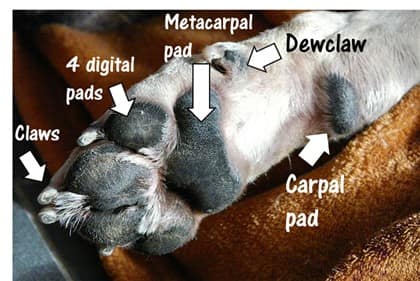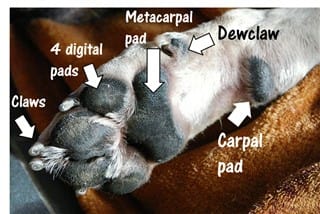Boxer Dog Paw Care
Overview
If there’s any one area of a dog’s body that takes a beating and is expected to stand up to lots of wear and tear, it’s the paws. And, in general, canine paws are rather sturdy.
This said, most Boxers need some regular care to keep the paws in top shape. In addition, you may find that certain issues may develop, which require treatment. And finally, it’s always wise to prep for certain seasons that will bring about some challenges regarding the paw pads.
This section will discuss everything you’ll want to know about your Boxer’s paws, including tolerance levels and the top 6 care tips.
Please note: AllBoxerInfo is reader-supported. Some of the product suggestions on this page are affiliate links. As an Amazon Associate we earn from qualifying purchases. This is at no extra cost to you and helps keep this site running.
About Your Boxer’s Paws
There’s 5 main areas of the paw.
The digital pads and the metacarpal pad work as shock absorbers; these are the areas of the paw that a Boxer mainly uses for typical walking.
The carpal pad, also known as a ‘stopper pad’, is a sort of ‘brake’ that is used when a dog is navigating slippery terrain or maneuvering on slopes.
The paws are the most durable (but not indestructible) area on a dog. As opposed to 3 layers of skin, there are 5. From inner to outer, these are: stratum basale, stratum spinosum, stratum granulosum, strtum lucidum, and stratum corneum.
The tiny pits and grooves that you’ll see on your Boxer’s paws are called small conical papillae (also found on a dog’s tongue, along with 4 other types).
Note that the word ‘conical’ refers to ‘cone shaped’.
If you run your finger over the papillae of your Boxer dog’s paws, you may notice that it may feel smoother in the centers of the paw pads, than at the outer edges. This will be more so for adult Boxers than Boxer pups. And this is because walking on certain surfaces over time (like pavement or cement) will gradual flatten the conical shapes into… well, not quite so conical.
This said, walking on a variety of hard surfaces over time will strengthen the paw pad surfaces and make them more durable, despite the papillae being flattened. And, we’ll touch on the element of toughing up the paws below.
Should I Try to ‘Toughen Up’ My Boxer’s Paws?
In short, yes, but do not go overboard.
The paw pads are made up of skin, fat, and collagen. So, the paws of a Boxer puppy that has not been outside much, or an adult that only mainly walks on grass and indoor surfaces, will be rather vulnerable. Soft-padded paws are much more prone to cuts and sores. Do note, however, that strong paw pads will not prevent a dog from receiving burns via hot surfaces (and we’ll touch on this in a bit).

About Nail Trimming
How often the nails need to be trimmed depends somewhat, but not fully, on how active a Boxer dog is, and over what type of surfaces he walks.
While nails will get filed down to come extent due to walking over certain surfaces, this alone is rarely sufficient. So, never assume that the nails will naturally ‘take care of themselves’. Natural filing is often jagged, which can cause the nails to split (super painful) or snag on carpeting. There’s also the risk of a nail becoming ingrown if left to grow too long.
Most Boxer dogs need their nails filed or clipped every 5 to 7 weeks. If you can hear the nails (a click, click over the tile or hardwood floors), this means that your Boxer is overdue.
You can do this yourself; personally, we like electronic grinders like the Dremel 7300-PT 4.8V Nail Grooming Tool . This is a pretty fast way to do it, and there’s less likelihood of accidentally clipping the quick (the vein that runs down the nail and bleeds like crazy if you snip it). But, clippers work as well.
. This is a pretty fast way to do it, and there’s less likelihood of accidentally clipping the quick (the vein that runs down the nail and bleeds like crazy if you snip it). But, clippers work as well.
Alternatively, if your Boxer puts up a big fuss or if doing the nails makes you nervous (quite common), you can have your vet or groomer do this for you. Typical cost is about $15.
The Cold and Hot Temperature Extremes that a Boxer’s Paws Can Tolerate
Your Boxer’s paws are designed to withstand the cold much more so than heat.
With the cold, the fatty layers in the pads act as insulation. In addition, canines have a system of blood vessels that quickly circulate blood from the lower extremities up to the main body where it is warmed, and then back down again.

This is the opposite of what happens to humans, in which there is reduced blood flow in extremities exposed to the cold.
The Boxer has something special in common with these animals?
Yep!
This particular type of circulatory network that dogs have
is very similar to what is found in other cold-weather animals including penguins (this occurs in their beaks), cold-water dolphins (this occurs in their fins), and arctic foxes (this occurs in their paws as it does with dogs).
Therefore, frostbite is much more common on a dog’s ears or tail than it is on the paws. Studies have shown that the canine paws can tolerate temperatures as low as -31 F. That said, frostbite should not be the line in the sand; exposure to frozen surfaces can quickly lead to overly dry paws, when can spiral rather fast into cracking.
With heat, the thresholds are what can be easily seen in the summertime
on a variety of surfaces. For canines, 120 F is the pain threshold, but with no permanent damage. A temperature of 140 F will cause burns, permanent damage, and scarring after 60 seconds. And at 150 F there will be rapid burns and blistering.
Ahead, we’ll talk about how to prevent winter drying and summer burns.
The Top 6 Paw Care Tips for Boxer Dogs
Bruce, photo courtesy of Peter Allen
#1 Routinely check the paws.
It is very common for small bits of debris to become trapped in between the toes and/or in between the paw pads. This may be sand, small pebbles, or other outdoor matter.
You’ll also want to check for cuts or injury. In the wintertime, ‘snowballing’, which is when tiny bits of ice or snow gets wedged between the toes, can cause the skin to split. And, check for any burns or sores, which unfortunately is common in the summer, and we’ll cover that in bullet #3.
#2 If you do spot a cut, if it is not that deep and the bleeding has stopped, you can rinse it well under a faucet, apply a wound ointment or gel like Vetericyn Plus Antimicrobial Hydrogel , and then slip a sock over your Boxer’s paw. You’ll find the most success with the sock staying on if you do it right as your Boxer is falling asleep.
, and then slip a sock over your Boxer’s paw. You’ll find the most success with the sock staying on if you do it right as your Boxer is falling asleep.
For any cuts that are deep, are actively bleeding, have pus, or are causing moderate to severe impediments in walking should be seen and treated by your Boxer’s veterinarian.

#3 Summer time care.
The main element here, in regard to paws, is hot walking surfaces. As we covered earlier, 120 F is a dog’s pain threshold, and at 140 F there will be burns.
So, how hot are walking surfaces? It really depends on where you live, if the sun is shining or not, and the type of surface. But, to give you an idea, we’ll look to the sunshine state, Florida.
Marcia Breithaupt of Liberty Pet Services did a really helpful study on how hot surfaces get
there, and we refer to this a lot.
Grass
stayed safe, only reaching a max temperature of 103 F on a 95 F day at 2 PM.
Cement
reached a painful 125 F at 2 PM. It cooled down to a safer 114 F by 4 PM.
Red brick
heated up quickly; it reached 125 F by 12 noon. By 1 PM, the brick was a burn-producing 135 F, and remained in the 130’s until 5 PM when it dropped down to 122 F, and then it was safe for a dog to walk on again at 6 PM when it when down to 110 F.
Asphalt
(blacktop pavement) was the worst. It was already over a dog’s pain threshold at 11 AM at 121 F. By noon it was 130 F and from 2 to 3 PM it was a shocking 140 F. It wasn’t safe again until 7 PM when it went down to 114 F.
What can you do?
1 - Avoid walking your Boxer during the hottest parts of the day; this is typically 11 AM to 2 PM.
2 -
When you do head out in the summer, try to stick to grass and/or the shade.
3 -
Use a quality paw wax on your Boxer. You may be surprised at how this works, and in what ways this is beneficial, and we cover this in care tip #5.
#4 Winter care.
As we touched on, your Boxer’s paws can withstand pretty cold temps, but that doesn’t mean that there aren’t any issues to contend with. There are several things that can really do a number on the paws in the winter.
The top 4 issues are:
Ice melt chemicals.
Most contain sodium chloride (rock salt), calcium chloride, potassium chloride, magnesium chloride, and/or urea (carbonyl diamide) which with extended exposure can cause chemical burns to a dog’s paws.
It’s not like you’ll head out with your Boxer and he’ll return with issues. Rather, it’s over the course of the winter that damage may occur.
Weeks or months in, you may notice your puppy or dog tending to his paws more due to irritation he's feeling, and the paw pads may appear overly dry or have cracking or sores.
Also, note that even if you don’t use these types of products at your own house, these are often tracked in from outside the neighborhood.
Snowballing.
We touched on this a bit earlier; this refers to when small, hard bits of ice and/or snow get wedged in between a dog’s toes or his paw pads. This pulls the toes apart, stretches the skin, and pinches at short hairs. As you can imagine, it is painful and the skin can rip in this very sensitive area.
Contact with frozen surfaces.
The typical canine family member rarely gets frostbite on their paws. But, weeks and months of walking on cold or frozen surfaces can lead to overly dry skin. While this will cause a Boxer to lick or chew at his paws, it can easily spiral into splits, cracks, and open sores.
Traction issues. Particularly relevant to senior Boxer dogs
and/or those with hip, knee, or back issues, but important to note with all is the importance of trying to limit slipping on ice and other surfaces in the winter.
Fortunately, a good paw wax can help prevent all 4 of these top paw concerns, and we dive into that next.

Chase, at 6 months old,
photo courtesy of Rishanth Hurdeen
#5 Use a quality paw wax all year round.
Here’s some things to note about paw wax:
- It is not a moisturizer in the sense that it will not cause the paw pads to become soft. In fact, never put human moisturizer cream on your Boxer’s paws, it’ll affect your dog’s ability to have good traction.
- A good one will allow the paws to breath. As you may know, dogs sweat through their paws (and a bit through their noses, and most extra moisture is expelled via panting). So, you won’t want to cover the paws with anything that would affect perspiration from exiting. A good paw wax does not interfere with the sweat glands.
- Paw wax is not at all related to ‘babying’ or spoiling a dog. In fact, with working dogs (farm dogs, sled dogs) and sporting dogs (those that participate in agility and sporting events) it’s extremely common to regularly apply paw wax.
There’s 5 top benefits to using a wax:
- Helps protect the paws from hot surfaces in the summer.
- Helps protect the paws from chemicals, snowballing, and cold surfaces in the winter.
- Helps keep the paws healthy and in good shape all year round.
- If damage has already occurred, can heal drying and cracking, and even minor sores.
- Helps a dog with traction.
To sum it up, using a paw wax on a regular basis can prevent your Boxer's paws from getting beat up and looking and feeling that way.
#6 For paw issues, a good paw wax coupled with a zinc and/or an omega supplement can help. Dietary zinc is well known to improve the health of paw pads, nails, and coat texture. And omega (fish oil) helps keep both skin and coat healthy.
Zinc works best to improve overall skin texture (if you’re trying to toughen up the paws) and an omega fish oil works best to improve dry skin problems.
You May Also Like:
Does a Boxer Dog Need a Car Seat? Check out what can happen if you don't buckle your Boxer up, and how a seat for a pup, or a belt for an adult can make car trips much more pleasant.
The Best Shampoos for Boxers
- What to use to keep the skin and coat super healthy, and specialty shampoos for certain issues that may be happening.
Boxer Dog Winter Care Tips
- Prep early so your Boxer is all set for when it's cold and snowy.






